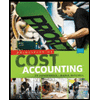
Concept explainers
- A. Name two principal types of cost accounting systems.
- B. Which system provides for a separate record of each particular quantity of product that passes through the factory?
- C. Which system accumulates the costs for each department or process within the factory?
(a)
Provide the two principal types of cost accounting systems.
Explanation of Solution
Cost accounting systems
It is a system which measures, record and report the product costs. In decision making process, managers use product cost for determining the prices of the product, controlling the operations of the business, and developing financial statements.
The two principal types of cost accounting systems are:
- 1. Job order cost system
- 2. Process cost system.
(b)
Provide the system that provides for a separate record of each particular quantity of product that passes through the factory.
Explanation of Solution
Job order cost system provides a separate record of each particular quantity of product that passes through the factory. Each quantity that is manufactured in the business is known as job.
(c)
Identify the system that accumulates the cost for each department or process within the factory.
Explanation of Solution
The process cost system accumulates the cost for each department or process within the factory. They are used by the companies which deal with manufacturing goods which are indistinguishable from each other and by using continuous manufacturing process.
Want to see more full solutions like this?
Chapter 2 Solutions
Managerial Accounting
- Prada Manufacturing had a Work in Process balance of $72,000 on January 1, 2022. The year-end balance of Work in Process was $95,000, and the Cost of Goods Manufactured was $730,000. Use this information to determine the total manufacturing costs incurred during the fiscal year 2022. Helparrow_forwardThe magnitude of operating leverage for Roshan Enterprises is 3.2 when sales are $200,000 and net income is $40,000. If sales decrease by 5%, net income is expected to decrease by what amount?arrow_forwardA company has a return on equity of 18%, and its total equity is $820.5. What is the net income?arrow_forward
- Company A has the following data: • Days in inventory: 18 days Days in accounts receivable: 12 days • Days in accounts payable: 20 days Company B has: • Days in inventory: 22 days • Days in accounts receivable: 15 days • Days in accounts payable: 30 days What is the cash-to-cash cycle time for Company A and Company B?arrow_forwardApex Manufacturing is reviewing its working capital efficiency. The company had credit sales of $500,000 last year. Its inventory turnover was 8 times, and its Days Sales Outstanding (DSO) was 36 days. The cost of goods sold for the year was $400,000, and the payables deferral period was 30 days. Assume a 365-day year. Calculate Apex's cash conversion cycle. Round your final answer to two decimal places.arrow_forward???!arrow_forward
 Managerial AccountingAccountingISBN:9781337912020Author:Carl Warren, Ph.d. Cma William B. TaylerPublisher:South-Western College PubPrinciples of Accounting Volume 2AccountingISBN:9781947172609Author:OpenStaxPublisher:OpenStax College
Managerial AccountingAccountingISBN:9781337912020Author:Carl Warren, Ph.d. Cma William B. TaylerPublisher:South-Western College PubPrinciples of Accounting Volume 2AccountingISBN:9781947172609Author:OpenStaxPublisher:OpenStax College Managerial Accounting: The Cornerstone of Busines...AccountingISBN:9781337115773Author:Maryanne M. Mowen, Don R. Hansen, Dan L. HeitgerPublisher:Cengage Learning
Managerial Accounting: The Cornerstone of Busines...AccountingISBN:9781337115773Author:Maryanne M. Mowen, Don R. Hansen, Dan L. HeitgerPublisher:Cengage Learning Principles of Cost AccountingAccountingISBN:9781305087408Author:Edward J. Vanderbeck, Maria R. MitchellPublisher:Cengage Learning
Principles of Cost AccountingAccountingISBN:9781305087408Author:Edward J. Vanderbeck, Maria R. MitchellPublisher:Cengage Learning College Accounting, Chapters 1-27AccountingISBN:9781337794756Author:HEINTZ, James A.Publisher:Cengage Learning,
College Accounting, Chapters 1-27AccountingISBN:9781337794756Author:HEINTZ, James A.Publisher:Cengage Learning, Cornerstones of Cost Management (Cornerstones Ser...AccountingISBN:9781305970663Author:Don R. Hansen, Maryanne M. MowenPublisher:Cengage Learning
Cornerstones of Cost Management (Cornerstones Ser...AccountingISBN:9781305970663Author:Don R. Hansen, Maryanne M. MowenPublisher:Cengage Learning





